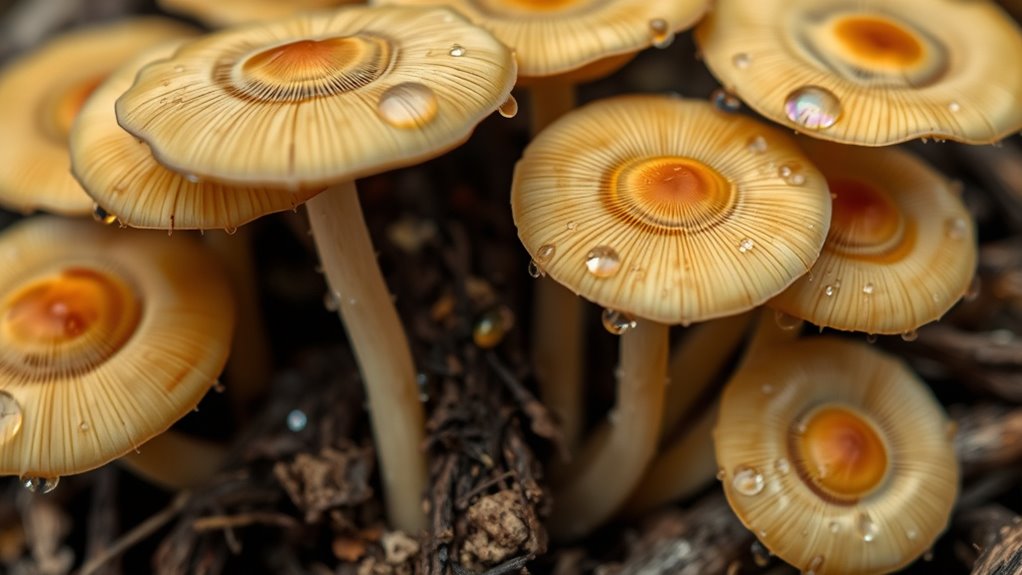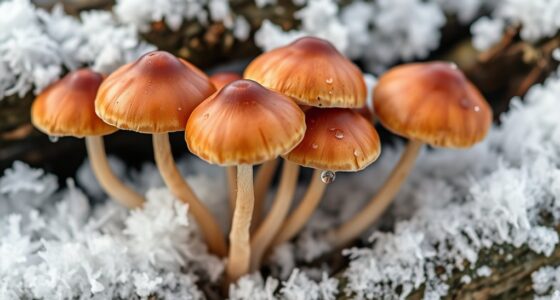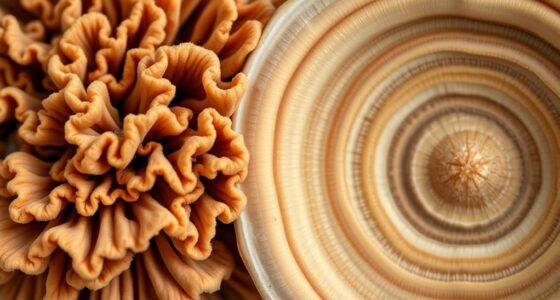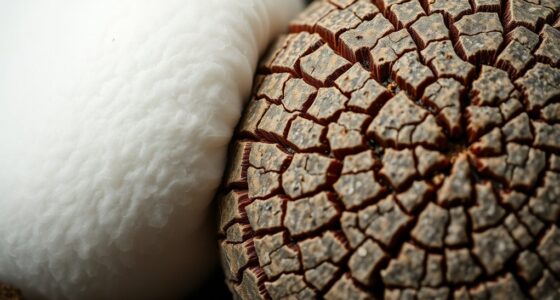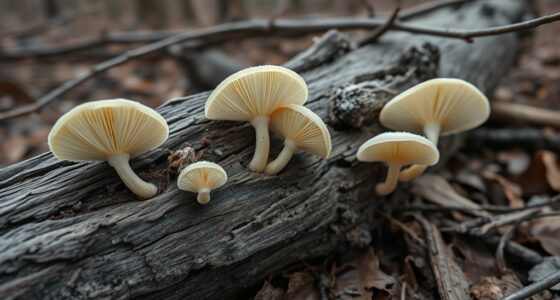Honey mushrooms (*Armillaria*) have honey-colored caps, fibrous texture, and often grow in clusters near tree roots. To identify them safely, look for a ring on the stalk and check their environment, but be cautious since many look-alikes are toxic or deadly. Never eat raw, and always cook thoroughly to neutralize toxins. If you’re curious about more tips on recognizing and harvesting these fungi, there’s plenty to discover ahead.
Key Takeaways
- Honey mushrooms belong to the genus *Armillaria*, identifiable by honey-colored caps, fibrous texture, and a ring on the stalk.
- Accurate identification requires examining features like spore prints and growth patterns; misidentification risks poisoning.
- Always cook honey mushrooms thoroughly before eating to neutralize toxins and improve flavor; raw consumption can cause health issues.
- Foraging should be done sustainably and away from polluted areas, respecting the environment and mushroom ecology.
- Confirm identification with multiple trusted sources or experts to prevent dangerous mistakes and ensure safe consumption.
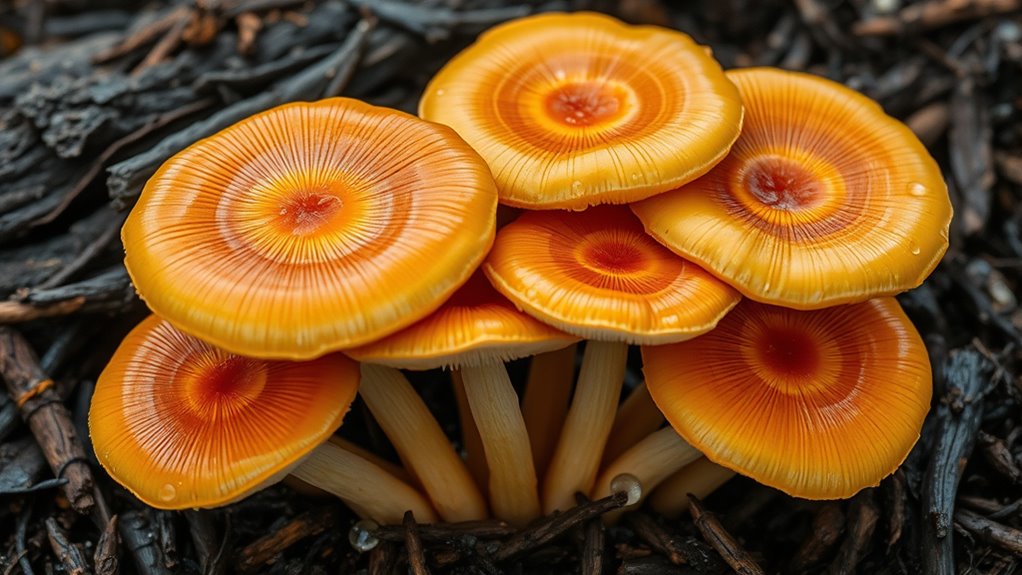
Have you ever stumbled upon a cluster of golden mushrooms growing on decayed wood? If so, you’ve found yourself at the crossroads of exploration and caution. Honey mushrooms, belonging to the genus Armillaria, are striking and abundant in many forests, but they demand respect. Foraging safety is paramount because misidentification can lead to serious health risks. These fungi often resemble other edible mushrooms, and some lookalikes are toxic or even deadly. Before you harvest, take time to learn their distinctive features: honey-colored caps, a fibrous texture, and a ring on the stalk. Always confirm your identification with multiple sources or an experienced forager, because even a tiny mistake can have severe consequences. Never rely solely on appearance; smell and spore prints can help distinguish honey mushrooms from lookalikes. Recognizing their distinctive features is essential for safe foraging. Once you’re confident in your ID, consider the culinary uses of honey mushrooms. They’re prized in many cuisines for their earthy, slightly sweet flavor and firm texture. You can sauté them with garlic and herbs, add them to soups or stews, or dry and store them for later use. Their versatility makes them a favorite among foragers looking to create flavorful dishes. However, even when properly identified, honey mushrooms should be cooked thoroughly to neutralize any potential toxins or indigestible compounds. Never eat raw honey mushrooms, as raw consumption can cause stomach upset or allergic reactions. Cooking also enhances their flavor and texture, making them more enjoyable and safer to consume. Despite their popularity, it’s essential to approach honey mushrooms with respect and caution. Foraging safety isn’t just about avoiding toxins; it’s about understanding the environment and biology of the mushroom. Honey mushrooms often grow in clusters, near the roots of trees, and their presence can indicate underlying tree health issues. Be mindful of where you pick them—avoid areas near polluted sites or treated lawns. Always harvest sustainably, taking only what you need and leaving enough behind to maintain the ecosystem’s balance. And if you’re unsure at any point, it’s better to err on the side of caution. Remember, the thrill of foraging is in the discovery, but the safety of your body is paramount. Proper identification, cautious harvesting, and thorough cooking guarantee you can enjoy honey mushrooms without risk, revealing their culinary potential while honoring the wild world they come from.
Frequently Asked Questions
Are Honey Mushrooms Edible Raw or Only Cooked?
You should only eat honey mushrooms cooked, not raw. Raw consumption can cause stomach upset or allergic reactions, so cooking is essential for safety. When cooked, honey mushrooms offer impressive nutritional benefits, like vitamins and antioxidants, that support your health. By preparing them properly, you liberate their full flavor and benefits, allowing you to enjoy this wild delicacy safely and fully.
How Long Do Honey Mushrooms Typically Last After Harvest?
After harvesting honey mushrooms, you typically have 1 to 2 days to enjoy them at their best freshness. To maximize mushroom preservation, store them in a paper bag in the fridge, avoiding plastic which traps moisture. Harvesting timing is key—pick them when they’re firm and fully developed. If you want to enjoy them longer, consider drying or freezing. Don’t wait—act quickly to savor their flavor before they spoil.
Can Honey Mushrooms Be Cultivated Commercially?
Yes, you can cultivate honey mushrooms commercially. With the right techniques, you control the environment, optimize harvesting, and maximize yields. You’ll master cultivation methods, refine harvesting techniques, and open the freedom of growing your own food. Embrace the process, break free from dependence on wild foraging, and enjoy the satisfaction of producing nutritious, delicious mushrooms on your terms. Take charge of your food source and cultivate your own success today.
Do Honey Mushrooms Have Any Look-Alike Toxic Species?
Yes, honey mushrooms have toxic look-alikes like false honey mushrooms. You need to be cautious because these false species resemble true Armillaria but contain harmful toxins. Always examine features carefully, such as gill structure and spore color, and avoid picking mushrooms if you’re unsure. By recognizing these toxic look-alikes, you can freely enjoy foraging without risking poisoning, ensuring your mushroom adventures are both safe and liberating.
What Are the Best Methods to Identify Honey Mushrooms in the Wild?
To confidently identify honey mushrooms, you need to master spore print techniques—simply lay the gills on paper and watch for their color. Don’t forget to examine the bark and gills closely, looking for the telltale honey hue and possible ring on the stem. Feel that surge of liberation as you decode nature’s clues, ensuring you pick only what’s safe, avoiding dangerous look-alikes.
Conclusion
Think of honey mushrooms as a double-edged sword in the forest’s story. Like a wise but cautious traveler, you must respect their beauty and potential, yet heed their hidden dangers. With careful identification and respect, you can enjoy their golden glow without falling into the shadows. Remember, in the wild’s grand tapestry, knowing the threads you weave keeps your journey safe and rewarding. Stay vigilant, and let curiosity guide your adventure wisely.

